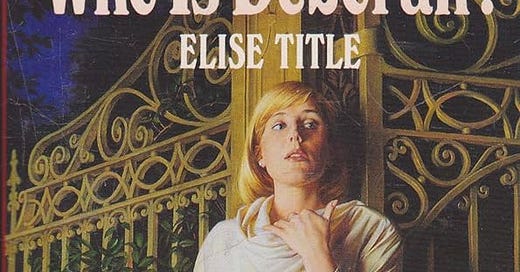Who Is Deborah?
Title: Who is Deborah?
Author: Elise Title
Publication Date: March 1993
Setting: The Catskills
Rating: Enjoyed
“I fell out of the lounge chair onto the ground. And then I was crawling. No, dragging myself along the grass like a soldier under fire. The landscape blurred around me as I moved closer to the edge of the bluff. I dragged myself on, closer, closer to the edge. As if I was being lured by a siren.”
I think I’m starting to guess why this series didn’t last long. Not because this book isn’t good–it’s a very solid little Gothic mystery with only the normal amount of plotholes for the genre. It’s just a complete tonal shift from The Last Cavalier, which was a dual view point time-traveling romance. Anyone reading that would not really expect what they get in Who Is Deborah?
Which is a first-person, single-person narrative from the perspective of amnesiac Katherine, trying to solve the mystery of her identity. When she is told she is Mrs. Deborah Steele, the missing wife of reclusive horror writer Nicholas Steele by a PI, she is so eager to claim a life outside of the psychiatric ward she agrees to go to Raven’s Cove and see if the memories start returning. But Nicholas is handsome, harsh and distant, his cousin/housekeeper Lillian is clearly hostile, and the question lingers…who, after all, is Deborah? It’s basically a Rebecca rehash, with the twist of amnesia and a heroine not sure if she’s Rebecca or the nameless second Mrs. de Winter.
Elise Title apparently had quite a background in criminal psychiatry, and she draws on the idea of ‘madness’, or more appropriately, mental illness, throughout. Katherine/Deborah/Elizabeth (the narrator’s true identity) suffers from amnesia throughout the book. “I think Nicholas Steele must be a little mad, myself…I mean, what person in his right mind could come up with such gruesome plots?” muses one of his fans, a question that haunts Elizabeth as she ponders whether he writes fiction or fact. Lillian, our Mrs. Danvers character, is constantly referred to as ‘mad’, ‘crazy’, ‘batty’, engaging in erratic malice, obsessed with her cousin Nicholas, and eventually trying to outright murder Elizabeth before being sent to a psychiatric facility. And our secondary hero (and true villain) Greg is “insanely in love with his best friend’s wife”, unable to separate Deborah from Elizabeth. “Yes, madness. There was madness in that house. Madness and terrible danger,” muses our heroine as she lies prostrate, drugged on her bed (because of course, it’s not a gothic unless the heroine gets locked up and sedated at some point).
While I appreciate that Elise was in some ways fairly sympathetic to the plight of her characters–psychiatrists are friends and helpers, mental illness is not met with cruelty but rather with medical help–the villainization of madness is perplexing, until one remembers she worked in the Manhattan penitentiary system. She seems to link the two. Elizabeth, the victim of assault, gets a nice diagnosis of amnesia and is never once associated with with the ugly word ‘madness’ (despite being the only character in the book who has spent time in a psychiatric ward), while Lillian’s violence is never diagnosed and she is instead hastily ushered off page.
There’s something to be talked about here–the way we treat certain mental illnesses differently than others; why too often they’re perceived as the natural precursor to violence; why those who suffer with them are seen as villains, not victims; and so on.
I don’t want to get too deeply into it–I’m no expert. But I find it fascinating that I’m two books in and I’ve hit up against two major issues in American society–our inability to see the Civil War and its legacy clearly, and our prejudice against mental illness. Both of these ideas are inherently Gothic, even if they’re not being expressed deliberately by their authors.




